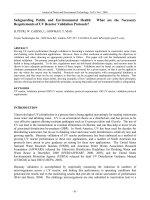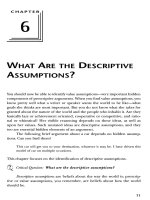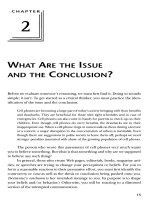What is culture and what are the influences ofculture? pot
Bạn đang xem bản rút gọn của tài liệu. Xem và tải ngay bản đầy đủ của tài liệu tại đây (11.83 KB, 7 trang )
What is culture and what are the influences of
culture?
A culture is the way of life of some society,
including its artifacts, beliefs, accumulated
knowledge, and the system of values in which its
members live. Also the arts, family life, child
rearing, custom of marriage and courtship,
education, occupations, government – in short,
the total effective legacy of the society which is
potentially available to its members.
The culture concept has the advantage of
enabling us to look at the whole society, making
clear the fact that one cannot understand group
behavior except as part of the culture pattern.
To understand a people, then we must look at
their physical environment (geography, climate,
natural resources, food supply, power resources
and industrialization), the human influences
(parents, siblings, friends, neighbors, colleagues,
teachers, police and other officials), their
institution (families, schools, churches, peer
groups, government, occupations), their artistic
expressions, their ideology (as expressed in
national or local rituals, constitutions, religions,
group loyalties, ancestor-worship) and the
manner in which they go about achieving the
three basic needs: self preservation, self-
reproduction and self-expression.
International exchange has become so quick and
easy nowadays that we are able to have more
contact with other cultures than ever before.
This crossing of cultures is stimulating and
enriching. In fact, it is by such cross-breeding that
civilization has advanced. Greece was fertilized
by what it learned from the ancient empires of the
East. Rome was brought out of barbarism by its
contact with Greek culture. Northern Europe
raised its civilization upon the contact with
Roman culture. After the dark Middle Ages,
contacts with Islam and the rediscovery of the
classics brought on a new flowering throughout
Europe.
Although the crossing of cultures is enriching, it
also has its dangers. The different cultures can
lead to confused signals, as when an Indian
shakes his head, he means “Yes”, but it is
understood “No” by foreigners; or when the
Japanese answers a negative question, “Didn’t
you go?” with “Yes” meaning “No”. These
confused signals become more serious when
they involve what we regard as discourtesies or
deceptions.
The German’s respect for authorities and officials
produces a kind of politeness or deference which
is discomforting to Americans who try to treat
everyone with equal casualness and to pretend
that no rank exists. It even seems insincere, and
therefore irritating.
The crossing of different cultures can lead to
misunderstandings and may cause conflicts.
Therefore they are divided into cultural groups by
their differences. And we should study such
groups so that when we go to distant places, we
can understand the others and can live with them
more friendlily and peacefully.









